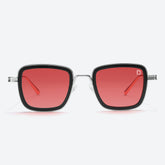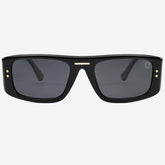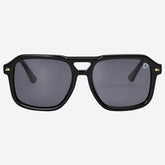What Are Single Vision Lenses: Difference between single vision and progressive?
Sure, you care about your eye health and went to an eye specialist. Now, you're at a shop with an eye prescription in your hand. Dollger suggests you get yourself all prepared before stepping into that eye shop. Because when he asks would you go for single vision lenses or digital progressive lenses? You will zone out. Wondering the difference between single vision and progressive. Save yourself some time and money. Read this article to tailor your buying of single-vision lenses or digital progressive lenses as per your need. We got you a bonus tip at the end. You don't have to keep switching between frames now. Let's find out which lenses to buy with Dollger!

What Are Single Vision Lenses?

Single vision lenses are surfaces of lenses with the same power along the entire lens. There's some amount of vision correction along the lens – either for nearsightedness, farsightedness, or astigmatism. Yes, you heard it right. You cannot treat your nearsightedness/farsightedness with a single piece of single-vision lenses. Uniform prescription through the entire surface corrects for one field of vision. Single vision lenses treat specific vision - that is myopia (nearsightedness), presbyopia (farsightedness), or astigmatism with constant correctness.
What Are Digital Progressive Lenses?

Unlike single vision lenses, digital progressive lenses have varying power along their entire lens. The smooth transitioning in between the lens has 3 regions for vision. The top region assists in viewing the far object clearly without blurring out the field for your nearsightedness. Whereas the bottom region of this lens helps you to see the words. More sharply on a book while you're reading. The intermediate lens surface between the top and bottom helps astigmatism. These multifocal lenses correct your nearsightedness, farsightedness, as well as everything in between.
Advantages and Disadvantages of Single Vision Lenses:
Advantages Of Single Vision Lenses:
Let's get through the advantages of single-vision lenses:
1. Simplicity:
Simple things are the easiest to adapt. Similar is the case with single-vision lenses. Their inability to focus on multiple visions makes them less complicated. These are straightforward and singlehandedly handle your either nearsightedness, farsightedness, or astigmatism!
2. Cost:
Who doesn't go for affordability? If you have vision impairment in a single direction, then single-vision lenses are the best option. They are cost-effective because there's no transitioning of multi-focal surfaces.
3. Clear Vision:
The phenomenon of a single-vision lens is the simplest. These are optimized for nearsightedness, farsightedness, and astigmatism. You don't have to tilt your head upwards or downwards to ensure vision correctness.
4. Easy Use:
People tend to buy single-vision lenses. Now, forget the different vision zones and enjoy the single frame for your eyesight correction!
Disadvantages Of Single Vision Lenses:
The following are the disadvantages of single-vision lenses:
1. Limited Range:
The biggest drawback of buying a single-vision lens for your frame is its limited range. It either deals with nearsightedness, farsightedness, or astigmatism. People above 40, with presbyopia and myopia end up buying multiple frames. With single vision lenses which costs them far more than digital progressive lenses.
2. Presbyopia Challenges:
A single-vision lens can't kill two birds with a single stone. These lenses do not correct seeing nearby objects. So older adults with presbyopia end up worsening their already damaged eyes.
3. Appearance:
In the case of bifocals or trifocals, people get lenses with visible lines. These lines divide the portion of the lens. This seems off-aesthetic and tougher to adapt.
4. Adaptation for Multitasking:
You could be driving and still find the need to look at the map. The task changed. You need two pairs of lenses with single-vision lenses. One navigates the way distantly while the other - at a map looking closely. This often gets exhausting without digital progressive lenses. You end up losing your focus with this less convenience.
Advantages and Disadvantages of Progressive Lenses

Advantages Of Progressive Vision Lenses:
Let's dig deep into the advantages of digital progressive lenses:
1. Smooth Transition:
The natural and seamless appearance of prescription progression from distant to intermediate to near lies in digital progressive lenses. There are no harsh lines on the surface of your lens reducing the quality of your vision.
2. Multifocal Convenience:
Unlike single-vision lenses providing a single-vision zone correctness, progressive lens provides 3 zones of vision. There are no telltale lines like bifocal lenses differentiating the near and far zones. Enjoy several prescriptions in a single pair of glasses.
3. Aesthetic Appeal:
As mentioned above, there are no lines on digital progressive lenses distorting the vision or visual appeal of your frame. The lens is modern and aesthetically pleasing as compared to single-vision lenses with the same thick conventional surface.
4. Versatility:
It supports multitasking. With a pair of digital progressive lenses, you don't have to worry about where is your frame. Either for long-sightedness or short-sightedness. You can multitask. Read a book as well as ask your roommate to leave (face recognition) without switching the glasses!
Disadvantages Of Progressive Vision Lenses:
Following are the disadvantages of progressive vision lenses:
1. Adaptation Period:
While tilting your head and finding the right vision area of the lens for a specific distance. This adaptation period becomes back-breaking. It takes a good amount of time for a person to adapt to progressive vision lenses.
2. Cost:
Despite all the goodness. The cost of progressive vision lenses is slightly high. The technology involved in the seamless transition portion and customization level according to the wearer's comfort requires extra money. The difference between single vision lenses and progressive is higher cost too.
3. Peripheral Distortion:
While digital progressive lenses correct the vision of nearsightedness and farsightedness all along. The peripheral vision suffers. It gets exhausting to focus on all three dimensions together with this highly focused pair of lenses!
4. Frame Limitations:
You cannot choose every frame. Cause there is a chance that the small frame might not be effective. The small frame limits the portion of the lens and hence the vision impairment.
Difference between single vision and progressive
There are two types of eye prescription. One includes single-vision lenses and the other one is digital progressive lenses. Single vision lenses account for correcting the single vision at a distance. Identical correction lies on the entire surface of single-vision lenses. Whereas, the progressive lens enables the vision correctness at different distances. Progressive vision lenses reduce the work. In a single frame, you get two lenses.
Let's find out the in-depth difference between the design and functionality of single vision and progressive:
1. Correction Range
Single Vision Lenses:
Vision correction for either near, far, or astigmatism.
Progressive Vision Lenses:
Multifocal lens transitioning from top (distance vision) to bottom (near vision) through an intermediate zone in between.
2. Transition Zone
Single Vision Lenses:
A single prescription lens with no transition.
Progressive Vision Lenses:
Gradual transition seamlessly shifts the focus from distance to close.
3. Use Cases
Single Vision Lenses:
Suitable for children/adults with conditions like myopia, hyperopia, and astigmatism.
Digital Progressive Lenses:
Suitable for older adults usually above 40 with presbyopia.
4. Appearance
Single Vision Lenses:
Uniform appearance and no harsh lines differentiate the portions of different prescriptions.
Progressive Vision Lenses:
Contemporary and aesthetically appealing look with no visible lines on the surface of the lens.
5. Adaptation
Single Vision Lenses:
Since there's only one prescription, the adaptation period is small with easy and simple use.
Progressive Vision Lenses:
The adaptation period is lengthy. It takes time to adjust the farsightedness, nearsightedness, and astigmatism all at once.
Enough swapping the frames. Whether you're driving or reading a book. Put on your frames with digital progressive lenses and help your daily life!
Product prices for single-vision lenses and digital progressive lenses
The difference between single vision lenses and progressive lenses is that their prices are relatively lower than progressive lenses. The smooth and continuous corridor of vision comes with a cost. You can find single-vision lenses for around $10. Whereas progressive vision lenses are around $20. There is a huge difference between the prices of both these pieces. However, the refractive index and quality to adapt different prescriptions are remarkable.
Usage scenarios of single-vision lenses and progressive lenses
Single Vision Lenses:
While wearing single vision lenses, you can either support distant, nearby, or intermediate vision. Distant vision includes driving, nearby vision includes reading, and intermediate vision includes screen time.
Digital Progressive Lenses:
These lenses are very useful for everyday use. Multiple focal points include multiple prescriptions. You can wear your progressive lens throughout the day while driving as well as reading. You can also wear it when using a computer for varying distances. So these glasses are ideal for people who want a single pair of glasses. Doing everything for them!
What aspects should you consider when purchasing lenses?
Age
Age is an important aspect when choosing lenses. You might think you need a progressive lens but hey wait. If you have either short-sightedness/long-sightedness, it could easily be solved with a single-vision lens. People with older age at risk of presbyopia need those digital progressive lenses!
Lifestyle
You cannot simply go and buy whatever pair of lenses seems affordable or aesthetically appealing. See, what are your activities throughout the day? And get a pair of lenses that fits everyday use.
Budget
Finding a balance between quality and affordability is the toughest. Look and find out which pair of lenses seems to solve the complexities of your vision with varying distances. You can also shop for frames at Dollger to let them fit your budget!
These are also the aspects you should consider when purchasing lenses:
Prescription Requirements
Lens Material
Coatings
Lens Design
Frame Compatibility
Usage And Lifestyle
Budget
Eye Health Consideration
Warranty And Return Policies
Eye Care Professional Guidance
Recommended by eye care experts
Digital progressive lenses are especially recommended by eye care experts to older adults with presbyopia. This common condition gets worse with age. In presbyopia, older adults find it difficult to focus on closer objects. Astigmatism is also a common age-related eye condition. It means they cannot focus on distant objects too. It is tiring to switch between two frames with single vision lenses. The bifocals are also less reliant and comfortable. So, no doubt, digital progressive lenses are a fine choice!
What product can Dollger help you?
Progressive lenses have specific lens materials that provide seamless transitions. The coatings are done so that there are no harsh lines between the surface of the lens. The multifocal design and technological advancement are what make these digital progressive lenses expensive. In the case of single-vision lenses, multiple frames are required for viewing distant or closer objects. The visual comfort and adaptation are sound and no doubt worth investing in. The precise customization of these lenses and preferences of frames is Remarkable. It is according to customers' choice at Dollger. And this is what keeps customers coming back. Find out the perfect frame at Dollger at budget-friendly prices without lessening the efficiency of your progressive lens
Conclusion:
Single vision lenses support a single prescription whereas digital progressive lenses provides multiple areas of vision correctness. It's difficult to find a perfect piece of frame fitting the progressive lens adequately. Most frames are either less aesthetic or less comfortable. These aren't durable enough to sit without pinching your nose or hurting your head.! The difference between single vision lenses and progressive is simple. Progressive lenses enable multitasking. It also fulfils different prescriptions, and aesthetic appeal. Along with modern technology as well as durability and affordability. So what are you exactly waiting for? Visit Dollger today and find your ideal frame for digital progressive lenses!





